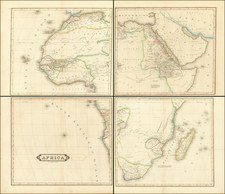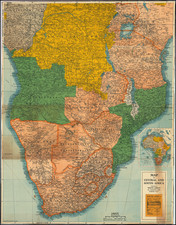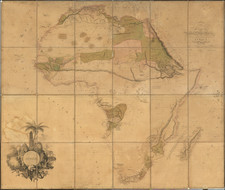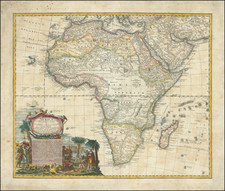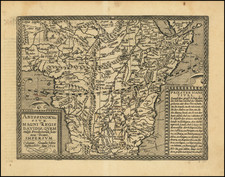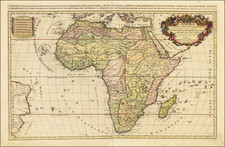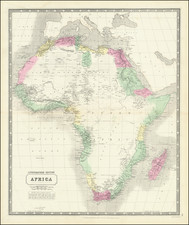Fine example of Daniel Lizars' 4 sheet map of Africa, which shows the extent of European knowledge of the continent in stark visual detail.
When the present map was issued around 1825, European knowledge of Africa was still quite limited. While the coastal outline of the continent was well understood, and in some cases scientifically mapped, the map shows that much of the interior remained a complete enigma.
The only notable forays into the interior regions are evident, being in South Africa (Dutch and British expeditions), Mozambique, Angola and the Congo (Portuguese explorations), the Lower Nile Valley (French and British expeditions) and fleetingly, in West Africa.
The efforts to penetrate the interior of the West Africa were the most recent and interesting. The Africa Association, formed in London in 1788, sponsored numerous expeditions to ascend the Niger and Gambia rivers, in the hopes of reaching Timbuktu, the great trading city of lore. The most notable endeavors to date were the expeditions of Mungo Park who, from 1795 to 1806, was responsible for filling in the crescent of detail which cuts across the empty space through West Africa on the map. In spite of the valiant efforts of the British, it would be French explorers working for the Société de Géographie, most notably René Caillié, who would reach Timbuktu and would consolidate French hegemony over the interior of West Africa.
The Lizars were a Scottish family of engravers and printers who produced many views and maps. Daniel Lizars Sr. (1754-1812) was the son of a shoemaker, but he apprenticed with Andrew Bell, a printer and engraver. Lizars set up his own printworks near St. Giles Cathedral and took on his own apprentices, including George Bartholomew, whose son John would go on to found the important mapmaking firm later know as John Bartholomew & Son Ltd.
Daniel Sr. had three sons: Daniel Jr., John, and William Home. He also had a daughter, Jane Home. Daniel Jr. (1793-1875), the youngest of the boys, apprenticed in his father’s shop alongside George Bartholomew. When his father died in 1812, Daniel Jr. took over much of the business, expanding it and specializing in maps. The company went bankrupt in 1832, however, and Daniel emigrated to Canada.
John Lizars (1792-1860), the middle son, studied medicine and became Professor of Surgery at the Royal College of Surgeons of Edinburgh, as well as senior surgeon at the Royal Infirmary of Edinburgh.
William Home Lizars (1788-1859), the eldest, also apprenticed in his father’s shop. After learning engraving, William entered the Trustees’ Academy to learn under John Graham. He was a skilled painter and artist. When his father died, and after his Daniel Jr. left, he carried on printing and invented a method of etching that looks like wood engraving.

